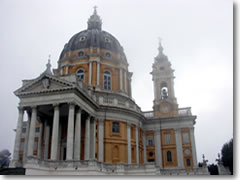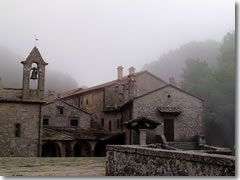Sleep for free in a monastery
Free sleeps for those suffering an unintentional vow of poverty
 The wildly rococo Basilica di Superga, designed by Filippo Juvarra and a scenic cog railway ride above the city of Torino in Italy's Piemonte region, is run by the Servi di Maria (Servants of Maria) lay order, and has a hostelry which will put up guests for €25 a person (+39-011-898-0083, www.basilicadisuperga.com)
The wildly rococo Basilica di Superga, designed by Filippo Juvarra and a scenic cog railway ride above the city of Torino in Italy's Piemonte region, is run by the Servi di Maria (Servants of Maria) lay order, and has a hostelry which will put up guests for €25 a person (+39-011-898-0083, www.basilicadisuperga.com)
This page covers:
• What monastery guest rooms are like
• What staying in a monastery is like
• Monastery costs
• Where monasteries are
• How to find monasteries
- Books on monasteries in Europe
- Books on monasteries in- the USA
- WebsitesThough most convents and religious hospices charge a modest fee of $20 or so (and are often found in places of pilgrimage, Rome being the biggest example), many monasteries will take in travelers absolutely free of charge.
What are the rooms in a European monastery like?
This page deals primarily with European monastery stays. Many other religious orders —notably Buddhists—also offer accommodations in Asia and elsewhere.Monks live in simple cells, and you should expect the same: modular furnishings, narrow beds, and a decorative scheme heavy on Jesus and the Virgin Mary.
You sometimes have to share a bathroom down the hall—but also often get to share home-style meals, either with fellow travelers or with the monks themselves.



The monastery of La Verna in Tuscany, Italy, was built on the clifftop site where St. Francis received the stigmata. It is a gorgeous little monastic hamlet (top) with simple rooms (middle; not pictured: my decor, which consisted of a crucifix above the bed) in a special guest wing of arcaded Renaissance corridors (bottom). » more Accommodations may be in a special wing of the monastery complex set aside for visitors, or in a dorm-like room of bunks, or even an unused monk's cell.
(For more on the actual experience of staying in one famous monastery in Italy, pictured to the right, see the page on our sister site ReidsItaly.com.)
What's it like to stay in an monastery?
Though pilgrims predominate, guests of all faiths (or none) are welcome. You are usually invited, though not required, to attend services and the calls to hours in the chapel.
There are plenty of rules: respect the monks, be fairly quiet, arrive for meals promptly, check in and out at the appointed times, and be back in your room (or at least in the guest wing) by curfew, which may be as early as 9:30pm.
Some have a minimum-stay requirement (usually two or three nights; a few require you to stay a "week," which may mean anywhere from five to seven nights)
In exchange for all this, you get a cultural exchange program at bargain-basement prices. Regardless of your own religious persuasion, this is an unparalleled opportunity to sample a bit of the monastic life and experience the quiet, reflective solitude of strolling the cloisters and gardens.
If nothing else, a monastery stay can be a welcome break from the hurly-burly of touring endless museums and cathedrals.
How much does it cost to stay in a monastery?
Sleeping for Free
Servas
CouchSurfing
Monasteries
Overnight trains in Europe
Sleeping in Airports
Crewing a Boat
Home Swapping
Hospitality Exchanges
House sitting
Free Camping in the U.S.
Though most religious hospices run by convents in Europe charge a modest fee of €20 to €60 per person (but note that that price usually includes at least two meals, breakfast and dinner, and often lunch as well), there are still some monasteries that will take in travelers absolutely free of charge.
This is because several monastic orders take "hospitality" as one of their rules, along with their vows of poverty and charity and the like.
That said, the majority of monasteries do charge modest per-night rates—about one-third the cost of a hotel (and, again, often including some or all meals).
Where are the monasteries in Europe?
Monasteries are rarely found in the big cities—unlike their sister pilgrim lodgings, convents, which are often in towns, particularly those with a strong religious connection (think: Rome, or Assisi).
Monasteries tend to be tend to be isolated out in the countryside, in mountainous or rural areas more suited to a monk's life of contemplation.
This can add to the triple benefit: a cheap (or free place to sleep, a unique cultural experience, and a chance to get off the tourist treadmill of Europe's major capitals and into the woods or small town to which the monks have retreated.
Resources for finding monastery stays
How do you find monasteries that offer lodging? Tricky. Ask local tourism offices. Do lots of Googling. Use these books and online resources:
Guidebooks to religious lodgings
Monasteries and convents in Europe
- Europe's Monastery and Convent Guesthouses: A Pilgrim's Travel Guide by Kevin J. Wright (buy it)
- Good Night and God Bless: A Guide to Convent and Monastery Accommodation in Europe, Volume I (Italy, Austria, Czech Republic) by Trish Clark (buy it)
- Good Night and God Bless: A Guide to Convent and Monastery Accommodation in Europe, Volume II (France, U.K., Ireland) by Trish Clark (buy it)
- Good Night and God Bless: A Guide to Convent and Monastery Accommodation in Europe, Volume III (Spain, Germany, Eastern Europe) by Trish Clark
- Bed and Blessings Italy by Anne and June Walsh (buy it)
- Lodging in Italy's Monasteries by Eileen Barish (buy it)
- Lodging in Spain's Monasteries by Eileen Barish (buy it)
- Lodging in France's Monasteries by Eileen Barish (buy it)
- Lodging in Britain's Monasteries by Eileen Barish (buy it)
Monasteries and convents in the United States
- Monastery Guest Houses of North America: A Visitor's Guide by Robert J. Regalbuto (buy it)
- Sanctuaries, The Complete United States: A Guide to Lodgings in Monasteries, Abbeys, and Retreats by Jack Kelly and Marcia Kelly (buy it)
Online monastery resources
There are also several good online resources—though the vast majority of places here listed will charge a modest fee; the free places are devilishly difficult to find.
- Good Night and God Bless (www.goodnightandgodbless.com) - Trisha Clark, author of the trio of guidebooks described above, also runs a website with links to hundreds of monasteries and convents that take in guests—mostly in Europe, but also in Africa, Thailand, and the USA.
- Hospites.it (www.hospites.it) - This Italian site is fairly complete, but confusing, with more than 3,000 listings in Italy. The "English" version really only gives you field names in English; the drop-down menus are still all in Italian. Here's what you need to know: Under "kind" try each of: "casa di accoglienza," "foresteria," "casa per ferie," and "casa vacanze."
- Monasterystays.com (www.monasterystays.com) - This is a booking site that reserves rooms at 320 properties (monasteries, convents, and other religious guesthouses) throughout Italy. It can help you avoid any language barriers and occasional deposit requirements (which often must be made through an Italian bank), and their criteria ensure you will have a private bathroom, however they do charge a modest fee. (How much of a fee? I can't tell you. I've asked several times and they refuse to reveal it.)
- Several major monastic and conventual orders list retreat programs and guesthouses online, including the Benedictines (www.osb.org) and Dominicans (www.op.org).
- Church of Santa Susanna (www.santasusanna.org) - Rome's American parish church holds a place in my heart, since it served as my public library when I was an adolescent living in the Eternal City. It also runs a remarkably useful Website that includes a page on convent accommodations across Italy, with the going rates and contact info for institutions in Rome, Assisi, and Venice. Again, not free ones, but mostly dirt-cheap ones.
- Zefiro World (www.go-to-italy.com/English/Religious.htm) - Has a line on around 60 monasteries and abbeys converted into hotels across Italy. Unfortunately, most of these are upscale hotel operations, not cheap dorms for pilgrims.
Related Articles
Free Sleeps Sections
|
Related Partners
|
This article was by Reid Bramblett and last updated in June 2011.
All information was accurate at the time.
Copyright © 1998–2013 by Reid Bramblett. Author: Reid Bramblett.

